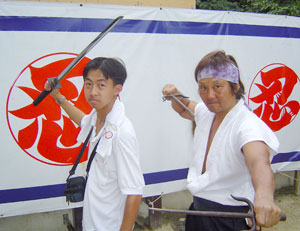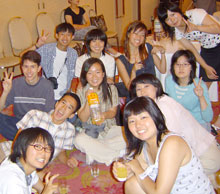My Japanese adventure
Billy, 18, liked seeing ninjas, meeting students and being on his own as an exchange student.
Visiting a martial arts museum, where Billy saw real ninja weapons and posed with a sword, was one of the highlights of his 10th-grade trip to Japan.

Photos by Rotary Club member
One day when I was in ninth grade, my high school Japanese teacher told the class about a student exchange program with the Rotary Club, in which we could live with a host family for two weeks during the summer. I knew that this was my chance to visit Japan. At first my parents said no because it cost about $900, but after a couple weeks they decided to let me go, to give me a chance to prove that I could be on my own. My older sister did more extracurricular activities than me and my parents thought she was really responsible. I wanted to show them that I could be responsible, too.
After I was interviewed and got accepted, I was told that they were going to postpone the trip until the next year, after 10th grade. When that school year finally ended, I was so excited. Some of my friends were jealous that I got to go to another country.
I was the only student on the trip from my school, Artesia High. Halfway through the plane ride, I started getting to know the other students and that made me less nervous.
When we got off the plane in Tokyo, a burst of heat hit us. Japan was much hotter during the summer than Los Angeles. We took another plane then a bus to our destination, a city called Yokkaichi. We passed many cities like L.A. but with smaller buildings. It was nighttime and there were bright lights everywhere. In Japan they drive on the opposite side of the road. By the time we finally got to our hotel, I was extremely tired because it took almost the whole day to get there.
For the first few days we stayed at a hotel. After eating breakfast we’d leave on a tour bus. I realized that I was wrong about Japan being really crowded. I saw tall mountains, green hills and rice paddies. Touring was more fun than being at home where I had to worry about homework. It felt like a school field trip, but better because at night I got to stay in my own hotel room.
We visited classrooms that were in session at Maryknoll Women’s School, a girls-only high school. Everyone had laptops on their desk. I thought it was interesting that the school provided laptops to use during class.
We saw Ueno Castle, which was really big and made out of gray bricks like the Great Wall of China.
My favorite thing was visiting the ninja museum because I got to finally see ninja combat in person. The ninjas showed us the tricks they used in their trick house, like revolving walls to hide from enemies, hidden escape doors and loose floor boards where they hide a spare weapon in case of an attack. They demonstrated swords, sickles, knives, ninja stars and a chain with a hook on one end. It was different than you would see on TV. On TV ninjas throw a lot of stars at once. But the stars are really heavy so ninjas can throw only one at a time.
Usually in the afternoon, when we had free time, I got to know my new friends. Joshua, Glenna, Timothy, Sharon and I, as well as the Japanese students who had gone to Los Angeles for the exchange program, went to stores and looked for things that we could buy or just to browse. I was surprised how we got along and became friends so quickly.
Would I accidentally insult their culture?
On the fourth day we met our host families, who we were going to live with for the next four days. I was pretty excited, but I was also worried that I might do something wrong that would insult them, like forget to take off my shoes in their house or eat food the wrong way. I was also worried that we might have a problem communicating. I was told that I was going to live with two families, the Kimotos and the Kobayashis.
Marie Kimoto was an only child who was the same age as me. The family spoke English but they weren’t fluent except for Marie so it was a little hard to talk to each other. After leaving the hotel, Marie’s father tried to ask me something in the car but I didn’t understand him because of his accent. Marie said he was asking where I wanted to go. I wasn’t sure, so he decided to go to the mountains, called Yunoyama.
I’d never been to a mountain before and at first I was kind of scared because I don’t like heights. We rode a cable car to the top and walked around looking at furry Japanese goats and down at the cities. It was great seeing everything from far away with the wind blowing. It seemed peaceful. The cities looked like tiny colored squares; I couldn’t tell the difference between America and Japan.
The next day we went to Marie’s school, Iino High, where I had to put my shoes in a locker and wear slippers when I came in.
Then we toured a Honda factory and ate lunch at a sushi bar. It was fun to see the sushi revolve on a conveyer belt by our seat. I grabbed plates with two pieces of sushi on them as they came by. Eating there was fascinating because of how they charged for the food—they counted how many plates were on your table.
In the afternoon we went to an amusement park where I rode roller coasters and played a shooting game. But the best part of the day was going to the mall. I saw Spider-Man 2, which was the same as watching it back home except there were Japanese subtitles. The mall sold kimonos and most of the signs were not in English.
That night, I got to light fireworks—it felt like the Fourth of July. Marie’s mother took us and the family’s friends to the baseball field near their home. Their friends didn’t know a lot of English, but we were still able to interact by cheering when one of us was about to light a firework.
Then it was time to switch to the Kobayashi family. At first I was sad and a little afraid of going to a new home.
Their home was less modern than Marie’s. It was more like the old Japanese style with sliding doors between rooms and tatami floors, which are traditional Japanese flooring made of woven straw. I slept on the floor on a traditional futon mattress. I was comfortable, but I still prefer sleeping in my modern bed at home.
There were bugs everywhere—spiders, roaches and flying brownish-gold beetles that hung onto tree trunks and were the size of golf balls. When I woke up, there were small red itchy bumps on my arms. I had a hard time going to sleep knowing that more insects might bite me.
They took me to the temple in Nara where there was an enormous statue of Buddha, the founder of Buddhism, which is practiced by many people in Japan. The statue seemed almost the size of a hotel.
Mr. Kobayashi gave his grandson and me brownish thin discs that were about the size of my hand. I didn’t know what they were at first, not until about 10 deer came to us to eat the food. We kept tossing it everywhere but they wouldn’t stop following us until I gave the deer food to someone else.
After three days, I left Mr. Kobayashi’s house and went to Gifu to watch cormorant fishing, which was a traditional event in Japan. I was so excited to see my friends again. I didn’t have much to talk about with the families I’d stayed with. We watched the fishing while riding in a boat and catching up.
It was amazing how the cormorant birds caught the fish. At night people in wooden boats hung a basket filled with burning logs in front of the boat to lure the fish out of the river, and the cormorants would catch the fish. Because of the string tied around the cormorants’ necks, they could not swallow them. I would have never guessed that people in another country used birds to catch fish instead of fishing rods.

Billy (top left) and other teens from his group goof around before meeting the Japanese host families they will stay with.
Although I was going to miss Japan, I was also homesick. I wanted to see my friends and family, and I missed my room—sleeping in my own comfortable bed and having my own space that I didn’t share with anyone. I also was excited to tell everyone about my trip. Since returning, I’ve stayed in touch with the friends I made. I talk to the ones who live in Japan by sending e-mails and writing letters, and chatting with the ones who live in L.A. on instant messenger.
I’m more outgoing now
Going to Japan for two weeks changed me a lot. I’m more confident now. Before, when it came to meeting new people, such as on the first day of school, I would usually be afraid to talk to anyone. But now I’m the one who introduces myself. In Japan I had to make a speech about volunteering in front of 70 people. That made me less nervous about making presentations at school and doing things in front of a crowd. I even ran for president of Key Club and won because I did a song and dance that showed club spirit.
I’ve always wanted to major in film. Now I want to go to college in Japan to study film. I grew up watching Japanese media and now I want to study it and maybe do it myself one day, all because of this trip. I can’t wait to go back to Japan and spend more than two weeks there to get to know it better.
To find out about Rotary Club youth exchange programs, go to www.rotary.org/programs/youth_ex/index.html
If you’re interested in other travel opportunities or stories about studying abroad check out Guianna Henriquez’s story about studying in Paris from January – February 2004.


